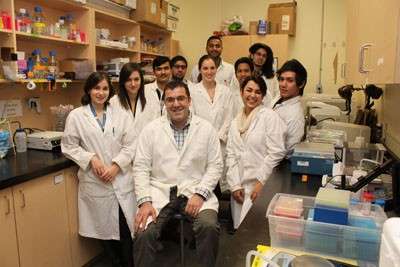New approaches to cell study contributes to cancer research

At Ryerson, some of our top researchers are committed to finding out how cells function, and to building our knowledge of the basic science of cellular function while investigating diseases and the potential for new therapies and diagnostics. They are supported by funds from the Canadian Institutes of Health Research (CIHR), the Natural Sciences and Engineering Research Council of Canada (NSERC) and by a growing network of partnerships with clinical laboratories in Toronto.
Faculty of Science professor Costin Antonescu looks at how cell surface proteins are regulated. "One of our main goals," he says, referring to his Ryerson lab group, "is to understand how this regulation is disrupted in tumours.
Hormones instruct cells on what to do by binding to a type of protein on a target cell's surface-termed hormone receptors, which act as molecular conduits of hormone action. When the proteins become disrupted, it can lead to many different diseases. A critical component of human cancer is a change in the organization and function of proteins found at the cell surface."
Antonescu is studying the epidermal growth factor (EGF), a hormone essential to many functions of the body—from healing wounds to normal heart function—but that in high levels can trigger cancerous growth.
"It's not just the presence of [epidermal growth factor receptor] EGFR that interests me," says Antonescu. "We are beginning to look at the spatial dimensions of hormone receptors. How do cells use protein scaffolds to create spatial organization?"
Protein scaffolds help connect a hormone, using a hormone receptor like EGFR, to the other molecules within a cell that enact the changes instructed by the hormone (leading to cell growth). It is a new and exciting approach, offering potential insight into cell mechanisms and signalling pathways. This may in turn suggest new treatments for diseases in which hormone receptors are disrupted, like cancer.
The Antonescu research group also studies how other types of proteins at the cell surface are regulated. One such group of proteins, called "integrins", is used by cells to attach to the correct location within specific organs. Antonescu's group is examining how cell stress—such as the stress a cell experiences when it does not have enough fuel (e.g., glucose)—signals to integrin proteins at the cell surface to change how a cell attaches to other cells and tissues.
Several types of molecules inside cells impact how these cell surface proteins are able to function. One such type is a family of lipids called "phosphoinositides." Antonescu's group studies how new properties of these phosphoinositide lipids control the function of proteins at the cell surface. This research may provide additional new methods to treat tumours, since many of the proteins at the cell surface (e.g., EGFR) are required for cancer cells to grow and spread.


















